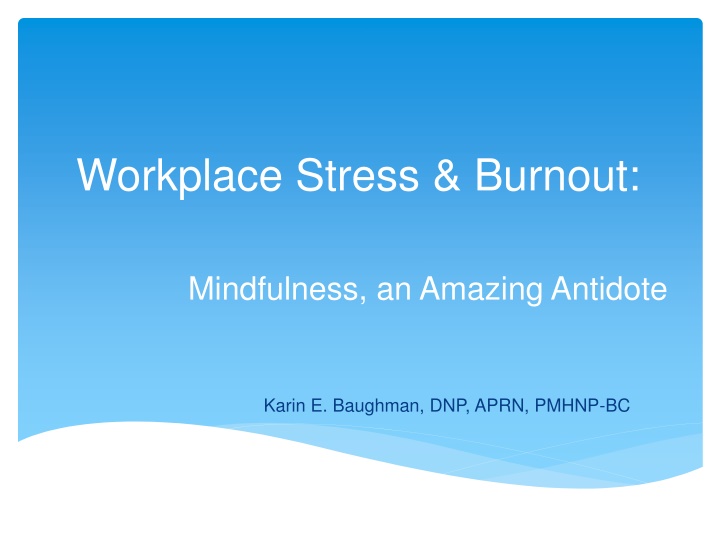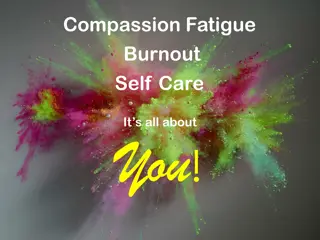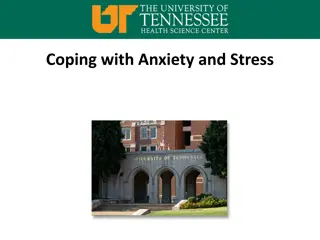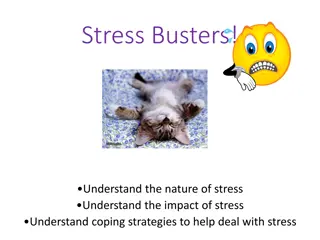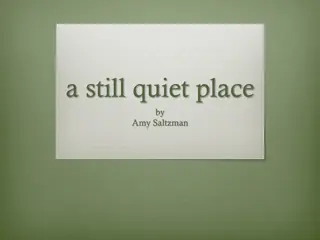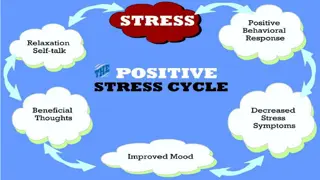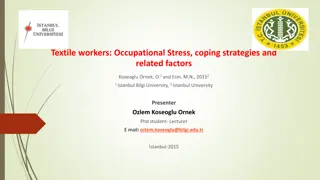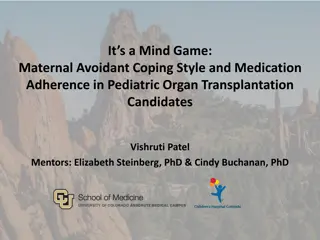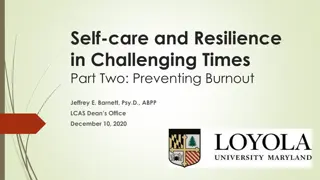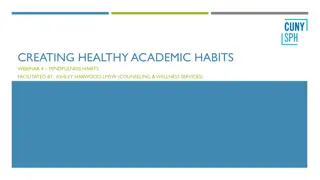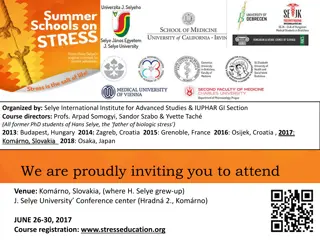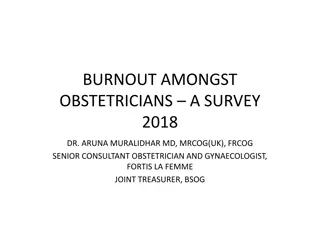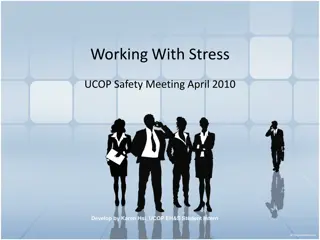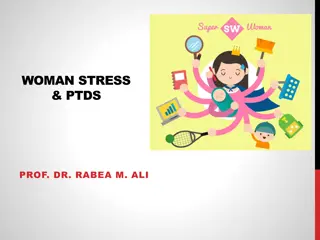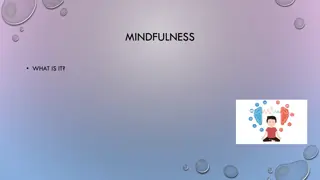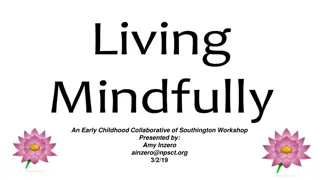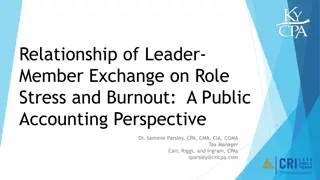Coping with Workplace Stress and Burnout: The Power of Mindfulness
Explore the impact of workplace stress and burnout, identify common sources and symptoms, understand the concept of burnout, and discover how mindfulness can serve as a powerful antidote for managing stress and promoting well-being in professional settings.
Download Presentation

Please find below an Image/Link to download the presentation.
The content on the website is provided AS IS for your information and personal use only. It may not be sold, licensed, or shared on other websites without obtaining consent from the author.If you encounter any issues during the download, it is possible that the publisher has removed the file from their server.
You are allowed to download the files provided on this website for personal or commercial use, subject to the condition that they are used lawfully. All files are the property of their respective owners.
The content on the website is provided AS IS for your information and personal use only. It may not be sold, licensed, or shared on other websites without obtaining consent from the author.
E N D
Presentation Transcript
Workplace Stress & Burnout: Mindfulness, an Amazing Antidote Karin E. Baughman, DNP, APRN, PMHNP-BC
Objectives Brainstorm sources of stress in your workplace Identify symptoms of workplace stress Define burnout related to workplace stress List symptoms experienced by those suffering from burnout Describe three components of mindfulness Explore outcomes associated with mindfulness Participate in mindfulness exercises
Close your eyes and picture yesterday at your workplace
What are sources of workplace stress?
How did you identify its presence?
Research supports what you know 69% say work is a stressor (APA, 2011) Turnover and staffing issues (Hayes, 2012) Quality and safety issues (Aiken et al., 2012) Higher rates of illness/workplace injury (Ayes et al., 2003) Compassion fatigue and burnout (Sabo, 2011)
How is burnout different? To be burned out means you were once on fire. Jesse Wilson, RN, MSN Emotional exhaustion Depersonalization Reduced feelings of accomplishment Result of chronic exposure to environmental stressors Person/job mismatch Common in people work
What happens when we quit caring?
Compassion Fatigue Suggests a therapeutic relationship exists Secondary trauma Stress results Emotional labor Burnout is suggested to be a precursor Amenable to treatment
What is Mindfulness? The awareness that rises when we pay attention, on purpose, in the present moment non-judgmentally (with kindness and curiosity) - Dr. Jon Kabat-Zinn he is the founder of Mindfulness-based Stress Reduction (MBSR).(1990) A mental state achieved by focusing one's awareness on the present moment, while calmly acknowledging and accepting one's feelings, thoughts, and bodily sensations, used as a therapeutic technique. 11
Presence of Heart (Kabat-Zinn. (2010). 12
Three Components Of Mindfulness https://unsplash.com/ 13
On Purpose 14
Benefits of Practicing Mindfulness 18
Benefits of Practicing Mindfulness 19
What does research show? Pro s Con s Mindfulness Research Methodology Improving (Goldberg et al., 2017) MBCT improved depression, anxiety, emotional regulation in those with BPD (Bojic & Becerra, 2017) MBSR helpful in treating BED (Kristeller, Sheets, & Wolever, 2013) Caregiver s helped by MBSR (see ref. list) Help for those with Diabetes and CAD (Keyworth, Knopp, & Roughley, 2014) Possible reporting bias in RCTs using MBSR (Coronado-Montoya et al., 2016) Drop out rates (Grossman et al., 2003) Homework required for full benefits (Pipe, et al., 2009) Practice makes perfect Modifications of MBSR make it hard to quantify (Grossman, 2004)- Glossary-MBCT-mindfulness-based cognitive therapy, BPD bipolar disorder, MBSR- Mindfulness-Based Stress Reduction, BED- binge eating disorder, CAD-coronary artery disease, RCT-randomly controlled trials 20
Practicing Mindfulness at Work Stop and take at least 3 deep breaths when you feel stressed. Try to take uninterrupted breaks to refocus and or stretch. Practice a walking meditation, simply slow down your pace & notice the ground against your feet. Participate in mindfulness offerings such as yoga, stress reduction or meditation classes. Utilize resources such as Mindfulness Based Stress Reduction program developed by John Kabat-Zinn PhD. Utilize meditation apps such as: The Mindfulness App, Get Some Headspace, Breathe2Relax, Calm, or MINDBODY Connect. 21
Breathing Changes Brain Chemistry Progressive Muscle Relaxation Four Square Breathing Inhale,2,3,4 Hold,2,3,4 Hold,2,3,4 Exhale,2,34 Repeat,2,3,4 23
Grounding Exercises 5-see 4-touch 3-hear 2-smell 1-taste 24
Increase Awareness: Remember S: STOP T: Take 3 breaths O: Observe Sensations, Emotions, Thoughts P: Proceed in a more modulated, less reactive, more responsive way (National Wellness Institute, 2015) 25
1-minute Take a breather Count your breath Inhale 1-2-3 Pause Exhale longer 1-2-3-4-5 Aware of this moment What do you notice from all 5 senses? What do you notice in your body? Tension? Holding a certain posture? Something else? Where are your thoughts? Past events? Future tasks? What are your emotions right now? Name what you notice. E.g. This is fear. This is sound. Let it be, let it go Simply observe whatever you notice, without trying to change it. Send yourself some kind and non-judgmental self compassion if this moment is a difficult one. See if you can make space for whatever you are feeling to be there without making yourself wrong. Remember that we all face difficulties in life sometimes; you are not alone. What would you say to a friend in the same situation? Think of something you are grateful for right now. Move mindfully Take a moment to stretch your body or stand up from your desk. Move mindfully into your next task, being truly present. 27
Mindful Eating (Pratt, 2019) 28
Loving Kindness Meditation: Just Like Me (Salzberg, 2014) 29
Summary Interventions to address the unmitigated effects of workplace stress are necessary. Cascading effects of unaddressed stress include burnout and compassion fatigue. Turnover , illness, injury, and quality/safety issues are also associated outcomes. Mindfulness is an inexpensive, easy to learn, readily available intervention with strong evidence of success in many settings.
References Adler, C. Harris, D., & Warren, J. (2017). Meditation for fidgety skeptics. New York: Spiegel & Grau American Psychological Association. (2011). Stress in the workplace survey summary. Retrieved 05/21/2018 from https://www.apa.org/news/press/releases/phwa-survey-summary.pdf Beach, M. et al. (2013). A multicenter study of physician mindfulness and healthcare quality. Retrieved 05/28/2018 from https://www.ncbi.nlm.nih.gov/pubmed/24019273 Bradt, S. (2010). Wandering mind not a happy mind. Retrieved 05/28/2018 from https://news.harvard.edu/gazette/story/2010/11/wandering-mind-not-a-happy-mind/ Chaskalson, M. (2011). The mindful workplace. Developing resilient individuals and resonant organizations with MBSR. West Sussex, UK: Wiley Dane, E., Brummel, B. (2014). Examining workplace mindfulness and its relations to job performance and turnover intention. Retrieved 05/28/2018 from http://journals.sagepub.com/doi/10.1177/0018726713487753 Goyal,M. et al. (2014). Meditation programs for psychological stress and well-being. Comparative Effectiveness Review No. 124. (Prepared by Johns Hopkins University Evidence-based Practice Center under Contract No. 290-2007-10061 I.) AHRQ Publication No. 13(14)-EHC116-EF. Rockville, MD: www.effectivehealthcare.ahrq.gov/reports/final.cfm. Goleman,D. & Davidson, R. (2017). Altered traits: Science reveals how mediation changes your mind, brain, and body. New York: Avery. Grepmair, L., Mitterlehner, F., Loew, T, Bachler, E. Rother, W. & Nickel, M. (2007). Promoting mindfulness in psychotherapists in training influences the treatment results of their patients: a randomized, double-blind, controlled study. Retrieved 05/28/2018 from https://www.ncbi.nlm.nih.gov/pubmed/17917468 Harris, R. (2007). The happiness trap: How to stop struggling and start living. MA: Shambala Publications. Haupt, A. (2016). Mindfulness in schools: When meditation replaces detention. Retrieved 05/21/2018 from http://health.usnews.com/wellness/mind/articles/2016-12-08/mindfulness-in-schools-when-meditation-replaces-detention Kabat-Zinn, J. (1990). Full catastrophe living: Using the wisdom of your body and mind to face stress, pain and illness. New York, NY: Dell Kabat-Zinn, J. (2010). Retrieved 01/27/2018 from https://youtu.be/xoLQ3qkh0w0 Kravits, K., McAllister-Black, R., Grant, M., & Kirk, C. (2010). Self-care strategies for nurses: A psycho-educational intervention for stress reduction and the prevention of burnout. Applied Nursing Research, 23, 130-138, DOI:10.1016/j.apnr.2008.08.002 Lindsay, K., Young, S, Warren Brown K., Smyth, J., & Creswell J. (2019). Mindfulness training reduces loneliness and increases social contact in a randomized controlled trial. Retrieved 02/15/2019 from https://wwwpnas.org/content/early/2019/02/05/1813588116 Marsh, J. (2013). How to train the compassionate brain. Retrieved 05/28/2018 https://greatergood.berkeley.edu/article/item/how_to_train_the_compassionate_brain 32
References Continued May,M. (2009). Eat what you love, love what you eat. Austin, TX: Greenleaf Book Group Press Moore, A., Gruber, T., Derose, J. & Malinowski, P. (2012). Regular, brief, mindfulness meditation practice improves electrophysiological markers of attention control. Retrieved 05/28/2018 from https://www.ncbi.nlm.nih.gov/pubmed/22363278/ n.a. (2018) Freeman Health System-21-day mindfulness challenge. Retrieved from https://www.freemanhealth.com/blog/mindful-meditation n.a. (2016). Mindful health and safety in the workplace research. Retrieved 05/21/2018 from https://www.ehs.uci.edu/gensafe/Mindful_Safety.html n.a. (2019). Mindfulness at work for less than $40. Retrieved 02/16/2019 from https:// . Entrepreneur.com n.a. (n.d.) Retrieved 05/21/2018 from https://en.oxforddictionaries.com/definition/mindfulness n.a. (2017). https://www.youtube.com/watch?v=-Ps1zVnvYdw O Brien, M. (n.d.). What is mindfulness and what does it mean to you? Retrieved 05/28/2018 from https://mrsmindfulness.com/what-is-mindfulness/ Pratt, K. (n.a.) Mindful eating exercise. Retrieved 03/04/2019 from htts://healthypsych.com/mindful-eating- exercise/ Purewal, N. & Petriw,K. (2018). Let that sh*t go. Toronto, Ontario: Harper Collins. Sabo,B. (2011). Reflecting on the concept of compassion fatigue. Online Journal of Issues in Nursing, 16(1),1 DOI: 10.3912/OJIN.Vol16No01Man01 Salzberg, S. (2014). Real happiness at work. NewYork: Workman. Schafer, W. (1987). Stress management for wellness. New York: Holt, Rinehart, & Winston. Siegel, D. (2007). The mindful brain: Reflection and attunement in the cultivation of wellbeing. New York: W. W. Norton Stahl, B. & Goldstein, E. (2010). A mindfulness-based stress reduction workbook. Oakland, CA: New Harbinger Publications. Sternberg, L. & Reising, H. (2015). Bringing mindfulness to corporate and community wellness: NWI webinar. Retrieved 05/21/2018 Stokowski,L. (2014). When nurses need nursing: The toll of emotional labor. Retrieved May 05/21/2014 from http://www.medscape.com/viewarticle/824689 Wongtongkam, N. , Krivokapic-Skoko, B. ,Duncan, R. & Bellio, M. (2017).The influence of a mindfulness-based, 134-143, DOI: 10.1080/14623730.2017.1316760 Yoder, E. (2010). Compassion fatigue in nurses. Applied Nursing Research 23, 191-197. DOI 10.1016/j.apnr.2008.09.003 33
